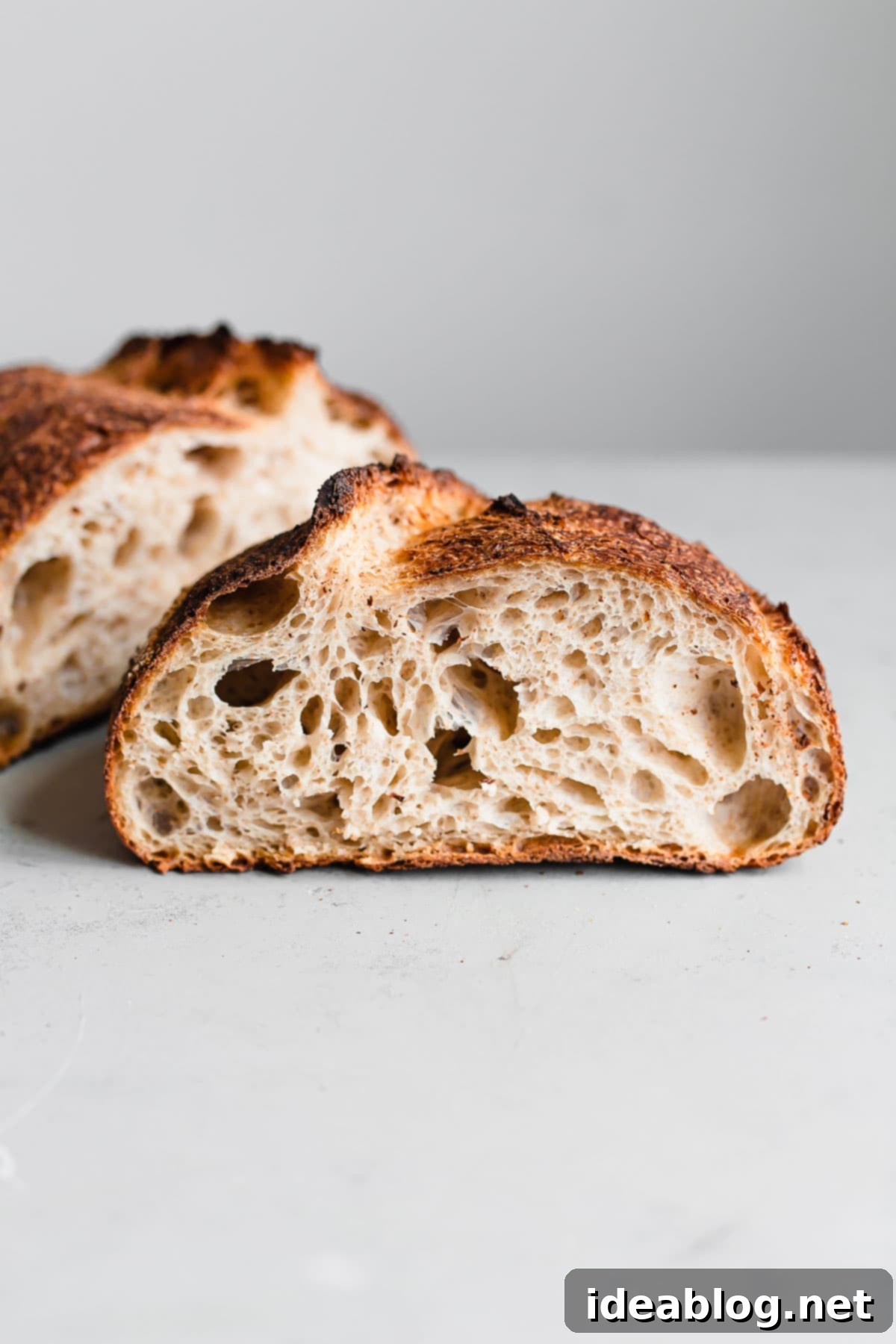Mastering Artisan Sourdough Bread: Your Ultimate Guide to a Perfect Loaf
Embark on a rewarding journey into the world of sourdough baking with my favorite everyday artisan sourdough bread recipe. This comprehensive guide, crafted from nearly two years of weekly baking experience, is designed to help you achieve consistent, delicious results. For visual learners and those seeking extra guidance, I encourage you to watch my step-by-step YouTube video and explore my extensive sourdough resources.
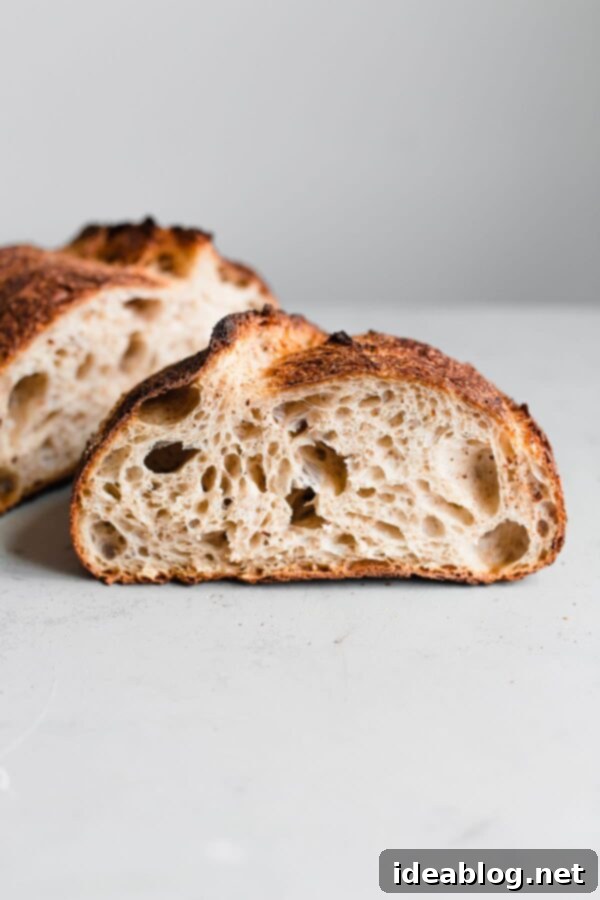
Sourdough bread baking, while demanding patience and dedication, has blossomed into a profound passion of mine. After meticulously cultivating a sourdough starter almost two years ago, I now bake homemade bread (and even sourdough pizza) at least once a week. The intricate dance of flour, water, and wild yeast consistently fascinates me, making each loaf a unique creation. It’s a truly fulfilling craft that I absolutely cherish.
With countless trials and successes under my belt, I’m thrilled to share my go-to, everyday Artisan Sourdough Bread Recipe. This particular method has consistently delivered the most exceptional results for me, yielding a naturally leavened loaf that is both beautiful and incredibly flavorful. My recipe focuses on a high hydration dough, composed of 80% high-protein bread flour and 20% stone-ground whole wheat flour. This specific combination is key to achieving an airy, delightfully chewy texture with a distinct open crumb structure.
Before you dive into the hands-on process, I highly recommend watching my new step-by-step YouTube video. It offers invaluable visual guidance that complements these written instructions. Additionally, for tips on oven baking, refer to my sourdough in a Dutch oven video.
Once you’ve mastered this fundamental recipe and feel confident with the process, don’t hesitate to experiment! You can vary the flour ratios to explore different flavors and textures, or incorporate exciting inclusions. For instance, my olive sourdough bread is a personal favorite that elevates this basic recipe into something truly special.
Recipe Note: This sourdough bread recipe provides a flexible timeline, but it’s crucial to understand that it needs to be adapted to your specific baking environment. Factors such as ambient temperature, the strength and maturity of your sourdough starter, and the type of flour you use all significantly influence fermentation and ultimately play a vital role in the final outcome of your homemade bread. Always observe your dough and let it guide you.
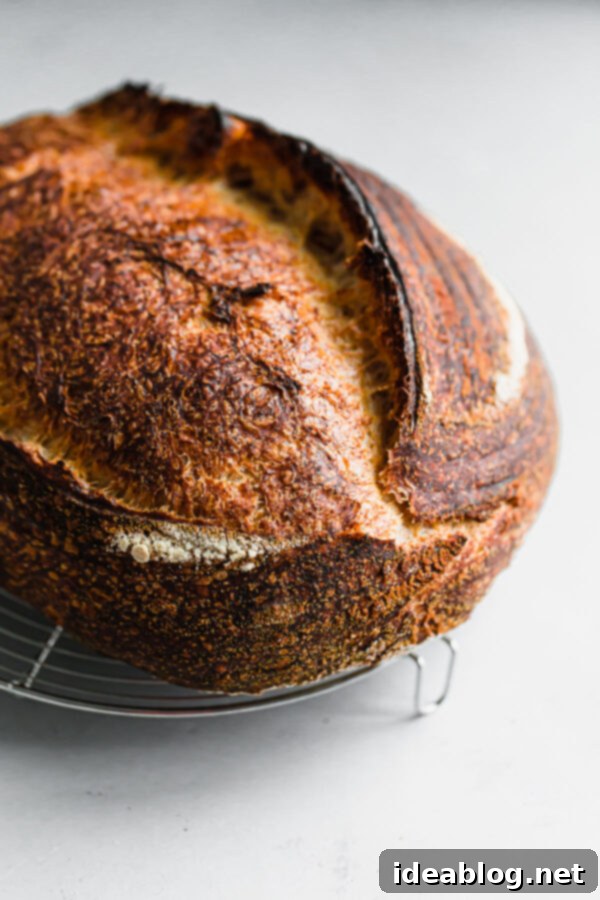
Sourdough Starter: Your Foundation for Flavorful Bread
The cornerstone of exceptional homemade sourdough bread is an active, mature, and vibrant sourdough starter. If you’re new to the world of sourdough, creating a starter from scratch is an incredibly rewarding process. I highly recommend guides such as The Perfect Loaf’s sourdough starter guide or Baker Bettie’s beginner guide. These resources provide detailed, step-by-step instructions to cultivate your own starter successfully.
Alternatively, if time is a constraint or you prefer to jump straight into baking, you can often acquire a starter from a fellow baker, a local bakery, or even purchase one online. Remember, sourdough starters are living organisms that thrive on consistent care. They require daily feedings to maintain their vitality, unless they are temporarily stored in the refrigerator to slow down their activity. While the commitment is minimal, regular feeding is absolutely essential for the starter’s viability and, by extension, the success of your bread.
Should you encounter any challenges or have questions regarding your starter, my dedicated Sourdough Starter Troubleshooting Guide offers a wealth of tips and guidance to help you navigate common issues. Mastering your starter is the first and most crucial step towards baking incredible sourdough bread.
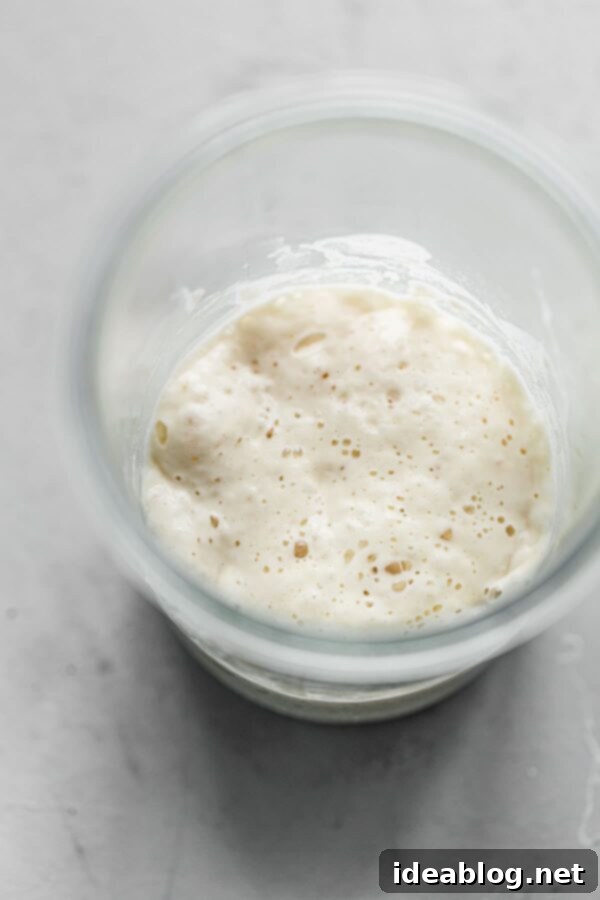
Ensuring Your Starter is Ready & Avoiding Common Mistakes:
Once you have nurtured an active sourdough starter and gathered a few basic tools (see a list below and a complete guide here), the exciting journey of baking your own sourdough bread truly begins!
How to tell if your sourdough starter is ready to use:
- To achieve optimal results with this recipe, you absolutely need an active, mature sourdough starter that follows a predictable feeding schedule. A healthy starter should reliably double or even triple in volume between feedings, indicating its robust activity.
- Ideally, your sourdough starter should require at least one, and preferably two, daily feedings at a 1:5:5 ratio (1 part starter, 5 parts flour, 5 parts water). For a deeper understanding of feeding ratios and their impact, please consult my Sourdough Starter Troubleshooting Guide. While it’s technically possible to bake with a less active starter, you’ll need to meticulously monitor your dough and likely extend the bulk fermentation period significantly.
- One of the most frequent errors new sourdough bakers make is poor fermentation and under-proofing, often stemming from using a weak or young sourdough starter. Under-proofed dough typically results in a dense, gummy texture and a poorly developed crumb structure.
- If your sourdough starter appears sluggish or isn’t performing as expected, I strongly recommend focusing on building its strength for another week or two through consistent feedings before attempting to bake. Remember, sourdough baking is an iterative learning process that requires immense patience and embracing trial and error.
If you’re experiencing any troubleshooting issues with this recipe or other sourdough baking endeavors, please refer to my comprehensive Sourdough Bread Troubleshooting Guide for detailed solutions.
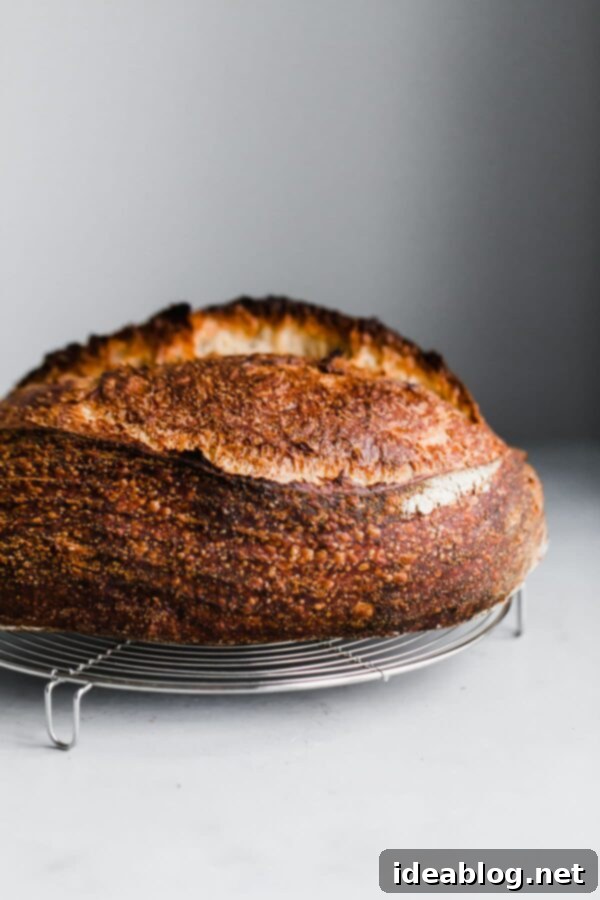
How to Make Artisan Sourdough Bread: A Step-by-Step Process
Important Note on Starter Usage: Many sourdough recipes suggest preparing an off-shoot levain specifically for baking. However, I prefer a simplified approach: I use a portion of my ripe, *just peaked* sourdough starter directly from my mother (main) starter. This method effectively streamlines the process, eliminating an extra step and seamlessly integrating with my regular feeding schedule and preferred baking timeline. The choice is ultimately yours, and you can tweak this to fit your personal schedule or starter’s feeding routine. Regardless of your approach, please ensure you account for the 90 grams of starter required for the recipe, in addition to the amount needed to maintain your mother starter.
To prepare for baking the following morning, I typically scale up my starter’s previous night’s feeding to the following ratio:
- 12 grams ripe starter
- 60 grams flour
- 60 grams water
*Note: This represents a 1:5:5 ratio (starter:flour:water). You may need to adjust or tweak this ratio to perfectly match your own starter’s activity level and feeding preferences.
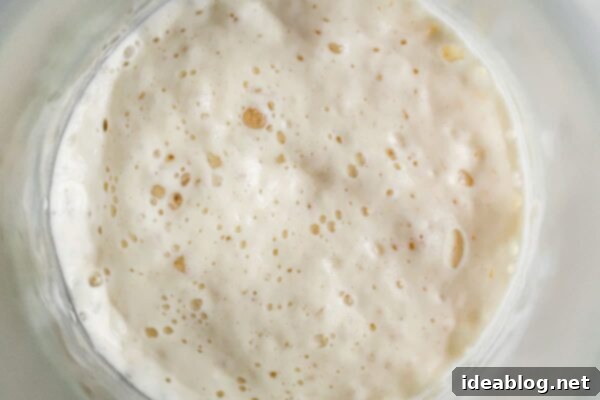
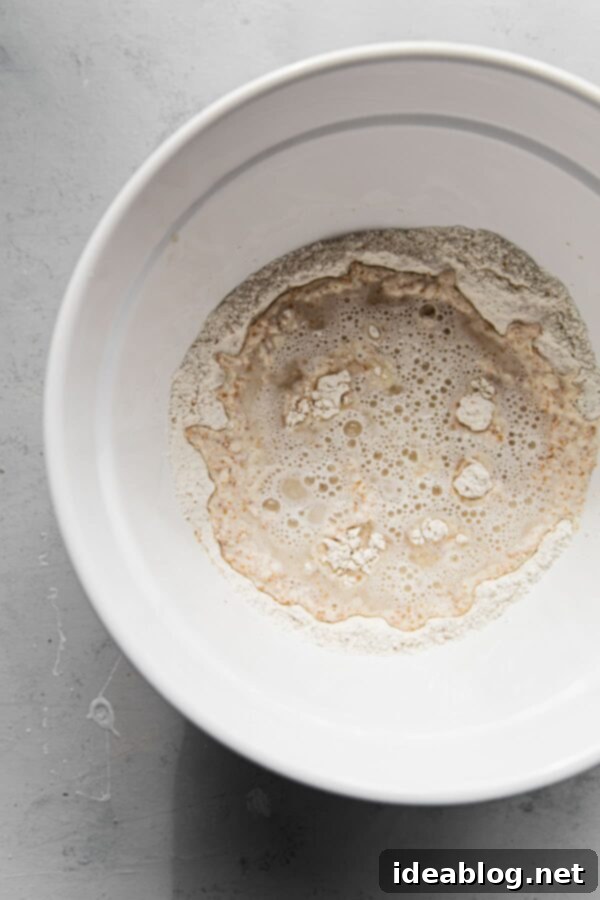
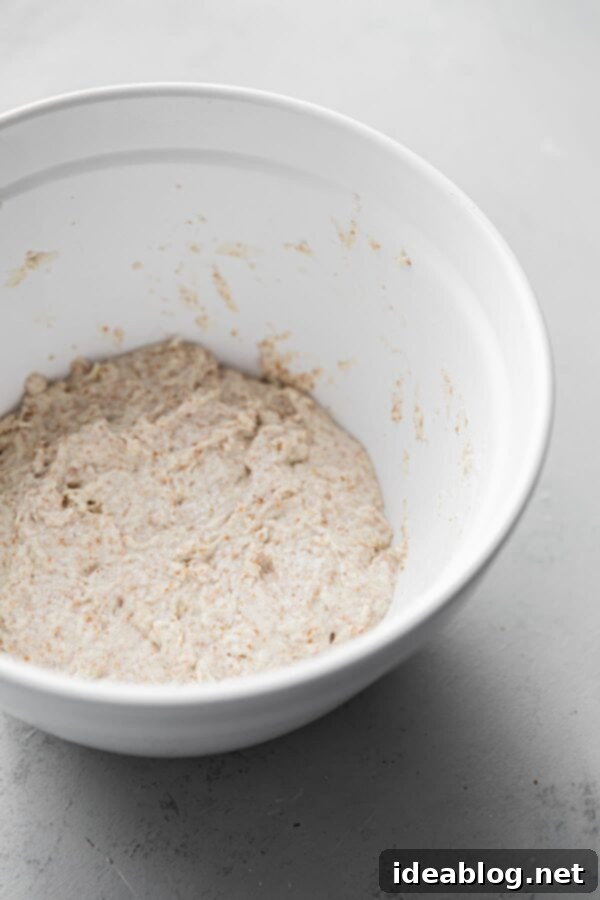
*Note: Before beginning, please watch my YouTube step-by-step instructional video for a visual demonstration of each stage. For a convenient printable recipe and an example baking timeline, scroll down to the dedicated recipe box at the bottom of this post.
STEP 1: PREPARE THE AUTOLYSE
Begin by thoroughly whisking together your chosen flours in a large mixing bowl. Next, add the filtered water, ensuring it is at approximately 90°F/32°C. Use your hands to mix the ingredients until they are thoroughly combined and no dry flour pockets remain. The mixture will be quite sticky at this stage. Cover the bowl securely with a clean shower cap or plastic wrap and allow it to rest at a warm ambient temperature of around 80°F/26°C for a minimum of 1 hour, or up to 2 hours. This crucial “autolyse” step allows the flours to fully hydrate, initiating enzyme activity and significantly aiding in the early development of gluten and overall dough structure.
To maintain a consistent fermentation temperature, I rely on my Brod & Taylor Proofing Box, an excellent tool for precise temperature control. While it’s a worthwhile investment for serious bakers, it’s not strictly essential. You can achieve similar results by finding the warmest spot in your kitchen (ideally between 74°F-76°F / 23°C-24°C) for resting your dough. Be mindful that cooler ambient temperatures will inevitably slow down the fermentation process, potentially extending your bulk fermentation period considerably.
*Planning Tip: Since this recipe utilizes a ripe starter directly rather than an off-shoot levain, I typically prepare and mix the autolyse roughly one hour before my usual morning starter feeding time. This timing ensures that my starter is perfectly ripe and has just peaked when it’s ready to be incorporated into the autolyse mixture.
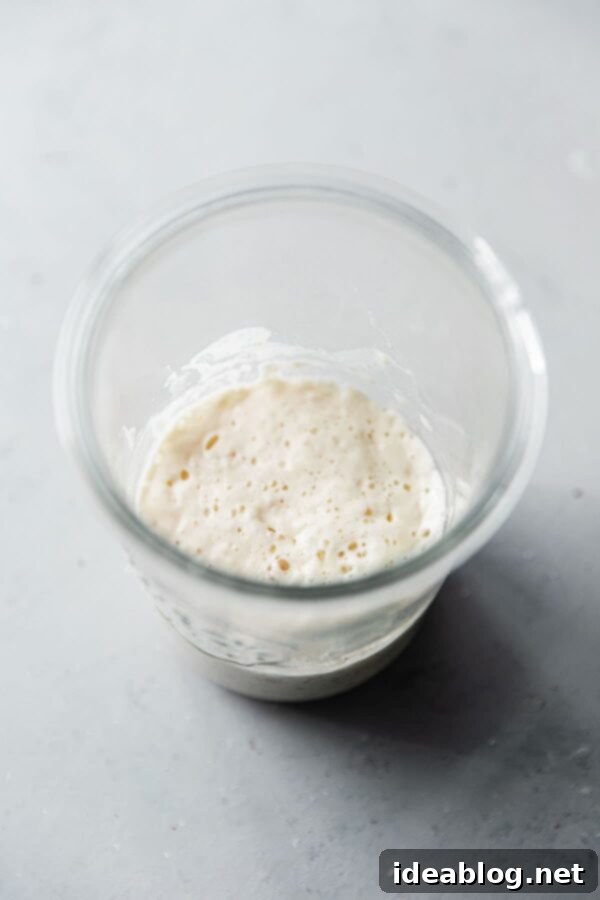
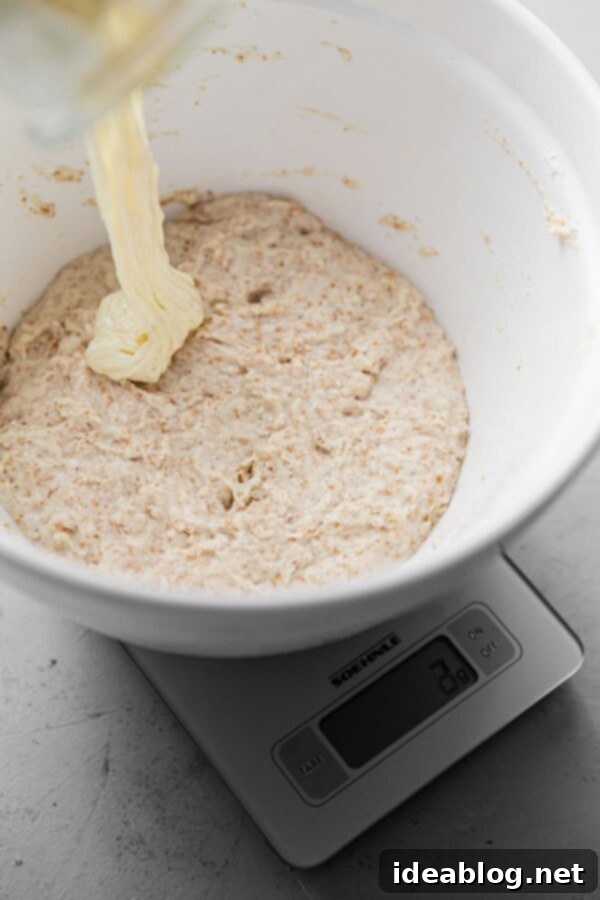
STEP 2: INCORPORATE RIPE STARTER AND REST FOR 30 MINUTES
Before adding your starter, you can perform the “float test” to gauge its readiness. While not entirely foolproof, a ripe starter should float when a tiny spoonful is gently placed into a glass of water. If it sinks, it typically requires a little more time to fully activate; retest after 15 to 20 minutes.
Once your starter passes the float test (or shows clear signs of peak activity), add the ripe, *just peaked* sourdough starter directly to your autolyse mixture. Use your fingertips to gently spread the starter evenly over the dough’s surface. Then, begin folding the edges of the dough into the center, effectively encasing the starter. Follow this with the “pincer method,” repeatedly pinching the dough between your thumb and fingers until the starter is thoroughly incorporated. Don’t be overly delicate here; the goal is to work quickly and ensure complete integration. Once mixed, cover the bowl again and allow the dough to rest at 80°F/26°C for 30 minutes.
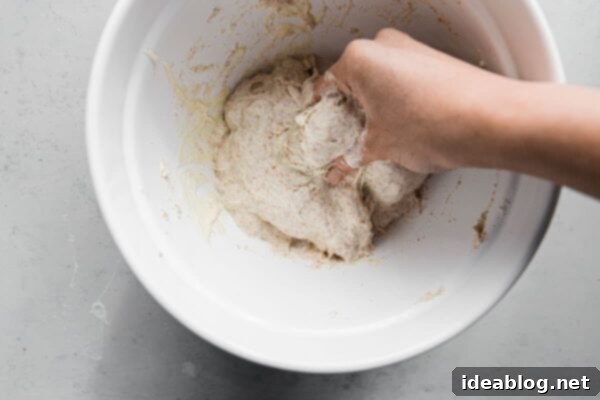
STEP 3: ADD SALT AND REST FOR 15 MINUTES
Evenly sprinkle the salt over the surface of the dough. Using your thumb and fingers, begin pinching and incorporating the salt deeply into the dough. Continue mixing until you no longer feel any salt granules, ensuring it’s thoroughly distributed. Depending on the coarseness of your salt, this mixing step typically takes about 3 to 5 minutes of focused effort.
If you find yourself struggling with higher hydration doughs or need to build additional dough strength, consider employing alternative mixing methods such as the “slap and fold” technique or the “Rubaud method.” These techniques can significantly improve gluten development. Please refer to the full video included in this post for a visual demonstration of these methods. Once the salt is fully incorporated, cover the bowl and allow the dough to rest at 80°F/26°C for 15 minutes before proceeding to the first set of stretch and folds.
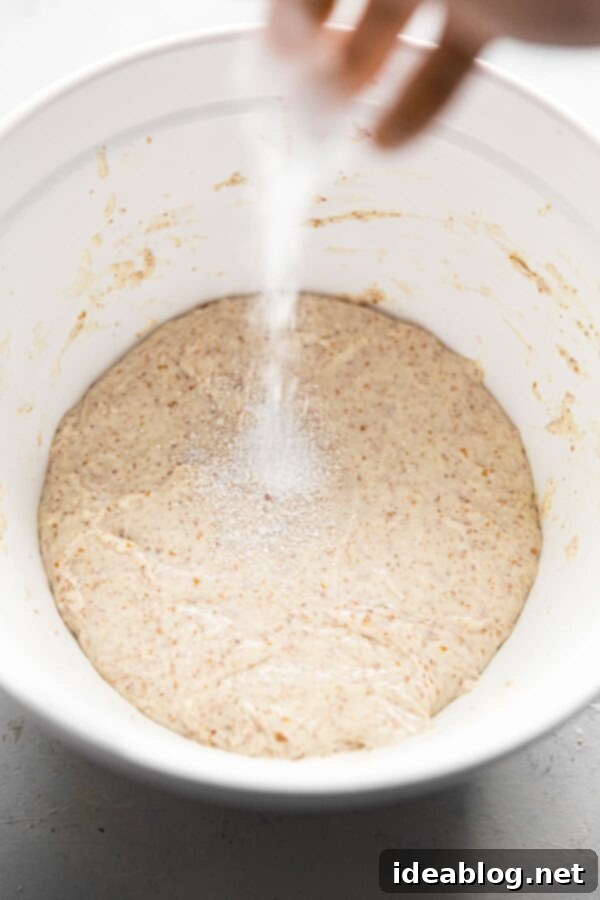
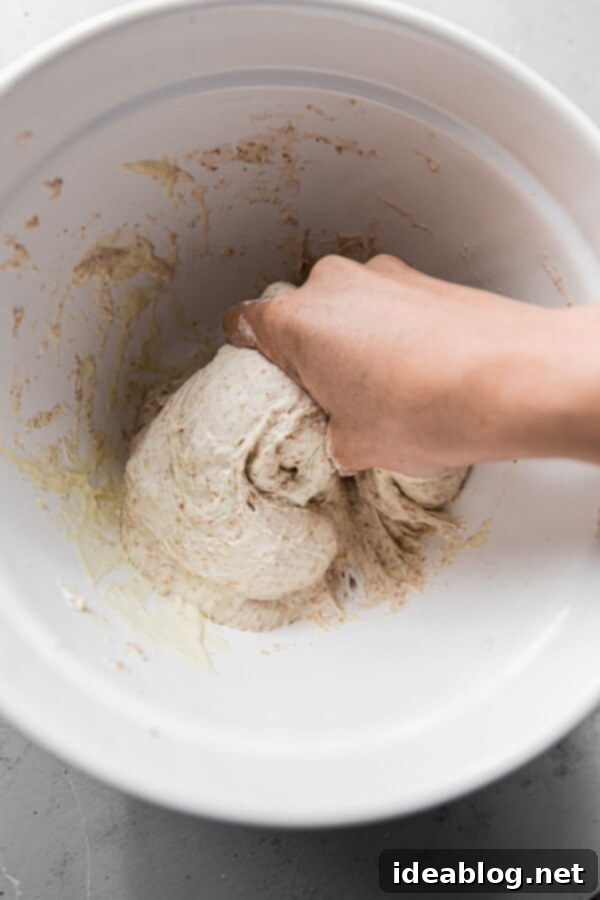
STEP 4: BULK FERMENTATION – THE STRETCH AND FOLDS
During the initial two hours of bulk fermentation, we will perform a total of six sets of stretch and folds. The first three sets will occur at 15-minute intervals, followed by the remaining three sets at 30-minute intervals. Stretch and folds are vital for building both strength and extensibility within the dough, which are critical for achieving a desirable open crumb structure in your finished bread.
To execute a stretch and fold: lightly dip your hands in water to prevent the dough from sticking. Be cautious not to incorporate excessive water, as this is already a high hydration dough. With both hands, gently grab the top portion of the dough. Carefully pull and stretch it upwards (without tearing it), then fold it over onto the opposite edge of the dough. Rotate the bowl 180 degrees and repeat this action from the other side. Next, rotate the bowl 90 degrees and repeat the stretch and fold on both remaining sides. This entire sequence constitutes one complete stretch and fold set. After each set, I like to gently lift and round the dough slightly in the bowl to maintain its structure (you can see this technique in the video). Cover the bowl and allow the dough to rest at 80°F/26°C between each set.
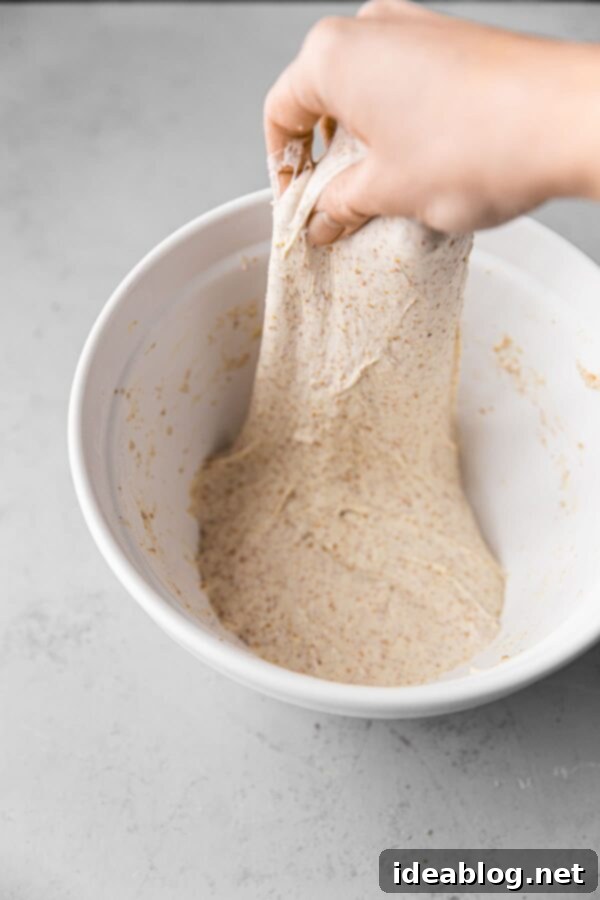
Initially, at the start of bulk fermentation, your dough will feel quite slack and loose. However, as you perform each subsequent set of stretch and folds, you’ll progressively notice it building more and more strength and tension. Note: It’s important to understand that the dough will not show significant rise or expansion during this initial period of stretch and folds; the primary goal here is structural development.
If your dough is lower in hydration, or if you feel it’s already developed considerable strength and is starting to “fight” you (i.e., becoming resistant to stretching), it’s perfectly fine to stop performing stretch and folds earlier than the prescribed six sets. Instead, allow it to rest for the remainder of the bulk fermentation period. The core purpose of stretch and folds is to build strength; if the dough has already achieved sufficient strength, additional sets can sometimes be counterproductive, potentially pressing out valuable gas bubbles and hindering its ultimate rise.
STEP 5: CONTINUED BULK FERMENTATION – THE FINAL RISE
After completing all your stretch and folds, allow the dough to continue resting, covered, at 80°F/26°C for an additional 1.5 to 2 hours. The critical indicator here is volume: the dough should have nearly doubled in size. It’s crucial to remember that the total bulk fermentation time can vary tremendously. Factors like your kitchen’s ambient temperature, the final dough temperature (FDT), the specific type of flour you’re using, and the activity of your starter all play a significant role. Therefore, continuous observation is key; always “follow the dough’s lead” rather than adhering rigidly to a clock.
Accurately determining the precise moment to conclude bulk fermentation and transition to the pre-shape phase is an art that comes with practice and a good deal of trial-and-error. Don’t be discouraged if it takes a few attempts to get it just right.
By the end of a successful bulk fermentation, the dough should be well aerated, exhibiting numerous visible gas bubbles on its surface and along the edges of the bowl (refer to the video for a visual example). The dough should appear slightly rounded at the edges of the bowl. If your dough remains flat, it typically indicates that you didn’t build enough strength during the mixing, stretch and fold, or early bulk fermentation stages.
Generally, I find the best results when I conclude bulk fermentation just before the dough fully doubles in size. This guideline has proven consistently effective for me within the context of this specific sourdough process and its associated timeline, leading to excellent oven spring and crumb structure.
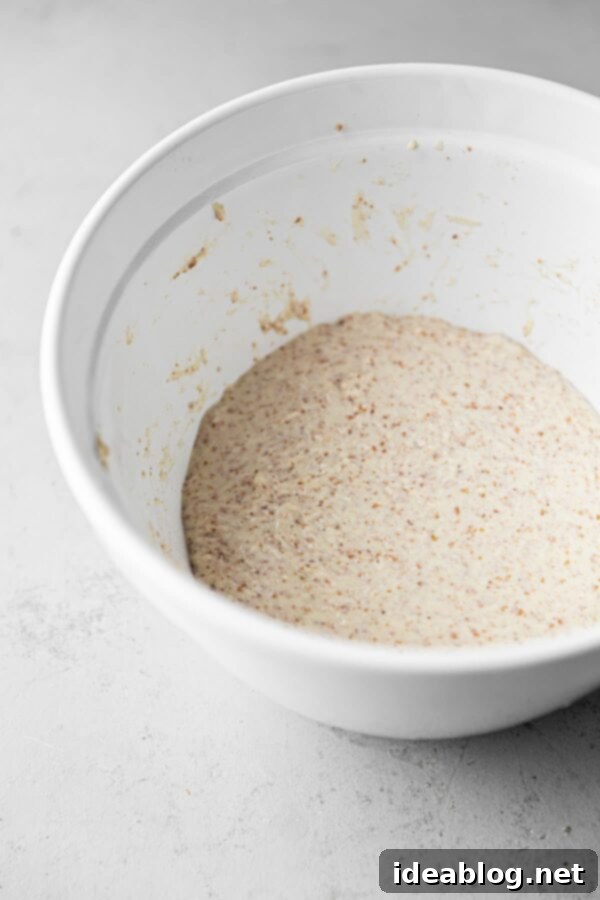
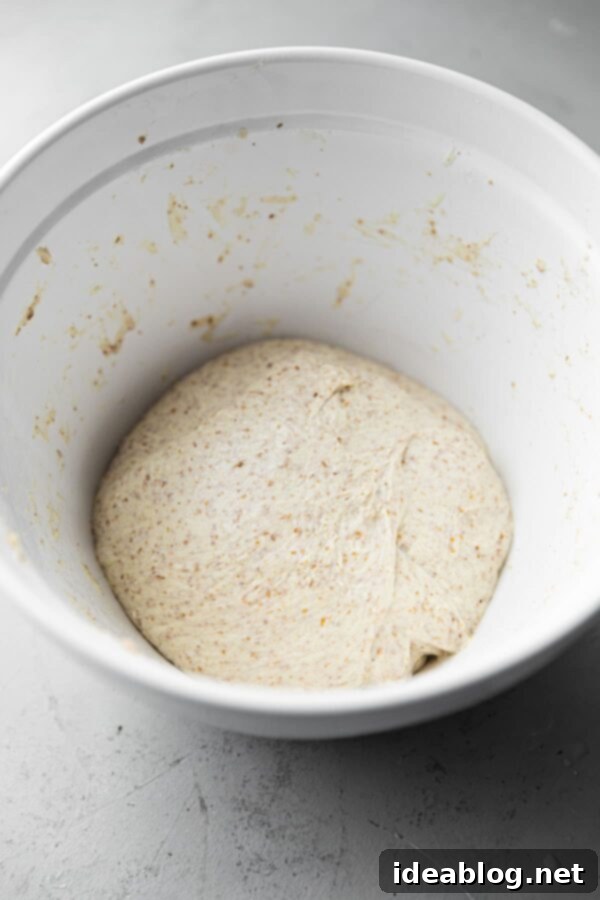
STEP 6: PRE-SHAPE THE DOUGH
With careful movements, transfer the fermented dough onto a clean countertop, taking care not to aggressively degas it. The dough will still be quite sticky. Employ a bench knife to gently guide and shape the dough into a loose round. As you do this, subtly pull the dough towards you on the countertop in a circular motion to develop some surface tension and initial strength. You’ll observe the dough starting to form a more cohesive shape and gain a slight bounce (refer to the video for a visual aid). The essence of this step is to execute it quickly and as gently as possible to preserve the internal gas structure. Once pre-shaped, allow the dough to rest, uncovered, for 15 to 20 minutes, or until it has noticeably relaxed, preparing it for the final shaping.
STEP 7: FINAL SHAPE THE LOAF
Generously dust your lined banneton basket with white rice flour; this non-gluten flour helps prevent sticking. Lightly dust the surface of your pre-shaped dough with a small amount of bread flour. Use your bench knife to carefully lift the dough and gently flip it flour-side down onto your clean countertop. Now, proceed to shape the dough into either a batard (oval) (as demonstrated in the video) or a round (boule) (refer to my Dutch oven shaping video), depending on your preferred basket shape and baking vessel.
Once shaped, carefully pick up the dough, flip it so the seam side is facing up, and transfer it into your well-floured banneton. Drape a clean linen cloth over the basket to absorb any condensation and then enclose the entire banneton within a plastic bag, sealing it with a clip. Allow the dough to rest at room temperature for a brief 10 minutes before transferring it to the refrigerator for its final proof.
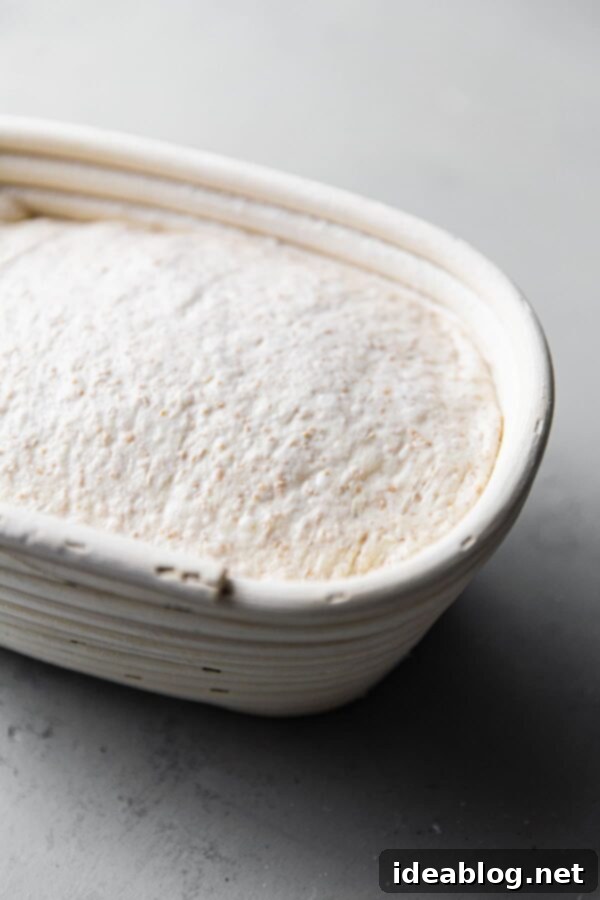
STEP 8: THE FINAL PROOF (COLD RETARDATION)
Place the covered banneton basket, containing your shaped dough, into the refrigerator. Allow it to cold ferment for 15 to 16 hours at a cool temperature of approximately 38°F/3°C. This extended, slow, and cold fermentation stage is absolutely crucial. It not only significantly deepens the flavor profile of your sourdough bread but also plays a vital role in improving the final texture and crispness of the crust, setting the stage for a truly remarkable loaf.
STEP 9: PREHEAT THE OVEN AND BAKING VESSEL
Approximately one hour before you plan to bake, place your Challenger Pan, Dutch oven, or combo cooker (with its lid on) into a cold oven. Preheat the oven to a blistering 500°F/260°C. Allowing the vessel to preheat for a full hour ensures it reaches and maintains a uniformly high temperature, which is essential for achieving an excellent oven spring and a beautifully caramelized crust.
STEP 10: BAKE YOUR ARTISAN SOURDOUGH
Once your oven and baking vessel have thoroughly preheated for the recommended hour, carefully remove the banneton from the refrigerator and uncover your dough.
The Poke Test for Proofing: To confirm your dough is perfectly proofed and ready for baking, perform a simple “poke test.” Lightly flour a small, discreet section of the dough while it’s still in the banneton. Gently press your finger into the dough. A properly proofed dough should spring back *very slowly*, leaving a slight indentation. This slow rebound is the hallmark of well-proofed dough. If the dough springs back quickly and completely, it’s likely under-proofed (in which case, return it to the fridge, covered, for an additional hour or so). Conversely, if your finger impression compresses the dough and it doesn’t spring back at all, it’s unfortunately over-proofed. While it’s difficult to fully rectify an over-proofed dough at this stage, rest assured it will still yield a delicious loaf, albeit with a potentially flatter profile.
Once proofed, transfer the dough to your preheated baking vessel (consult the recipe box below for more detailed instructions specific to your pan type). With a bread lame, score the loaf with your desired pattern. For visual instruction on scoring techniques, please refer to the recipe video. Bake at 500°F/260°C with the lid on for 25 minutes.
After 25 minutes, carefully remove the lid from your baking vessel. Reduce the oven temperature to 475°F/240°C (*Note: if your oven tends to run hot or your loaves are browning too rapidly, consider reducing the temperature further to 450°F/232°C). Continue baking uncovered for an additional 15-25 minutes, or until the crust develops a deep golden color and a beautiful caramelization. I often rotate the pan several times during this final baking phase to ensure even browning across the entire surface of the loaf.
Finally, carefully transfer the baked bread to a wire cooling rack. It is absolutely critical to allow the bread to cool completely before attempting to slice it. This process can take several hours, but it’s essential for achieving the best crumb texture and preventing a gummy interior. Once cooled, savor your homemade artisan sourdough!
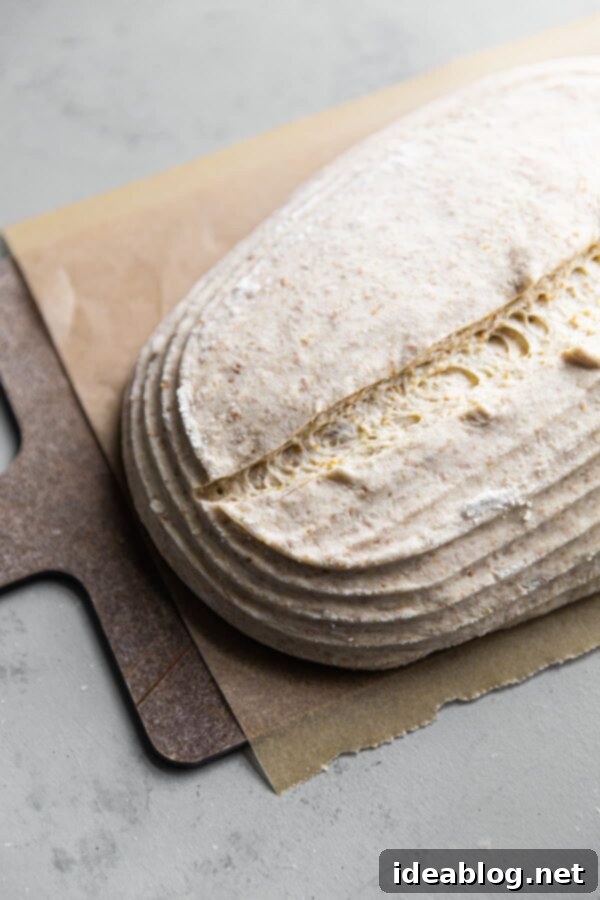
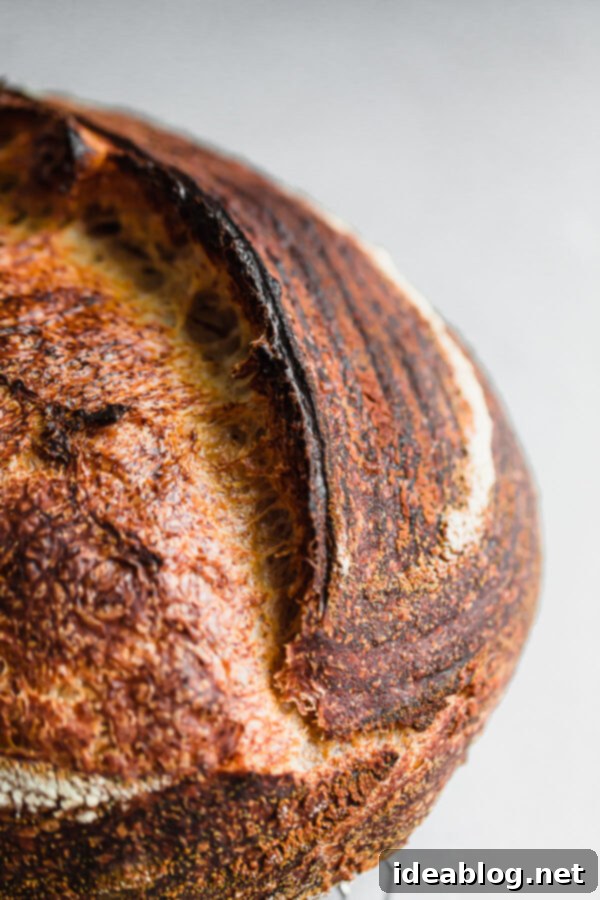
Artisan Sourdough Bread Ingredients:
- 350 grams bread flour (preferably organic, high-protein)
- 90 grams whole wheat flour (preferably organic and stone-ground for best flavor)
- 350 grams 90°F/32°C filtered water
- 90 grams ripe sourdough starter (at 100% hydration)
- 9 grams kosher salt (Diamond Crystal recommended) or fine sea salt
- White rice flour, for dusting your banneton basket
Baker’s Percentages for Customization:
The following baker’s percentages are provided to empower you to adapt and tweak this sourdough bread recipe according to your specific flour preferences, desired hydration levels, or yield requirements. While you’re free to adjust, I highly recommend maintaining the same salt and sourdough starter percentages for consistent results. Please note that significant alterations may affect the overall baking timeline.
- Bread Flour: 79.5%
- Whole Wheat Flour: 20.5%
- Water: ~79.5% (*Note: This is a rough hydration percentage; true hydration accounts for the flour and water present in your sourdough starter.)
- Sourdough Starter: 20%
- Salt: 2%
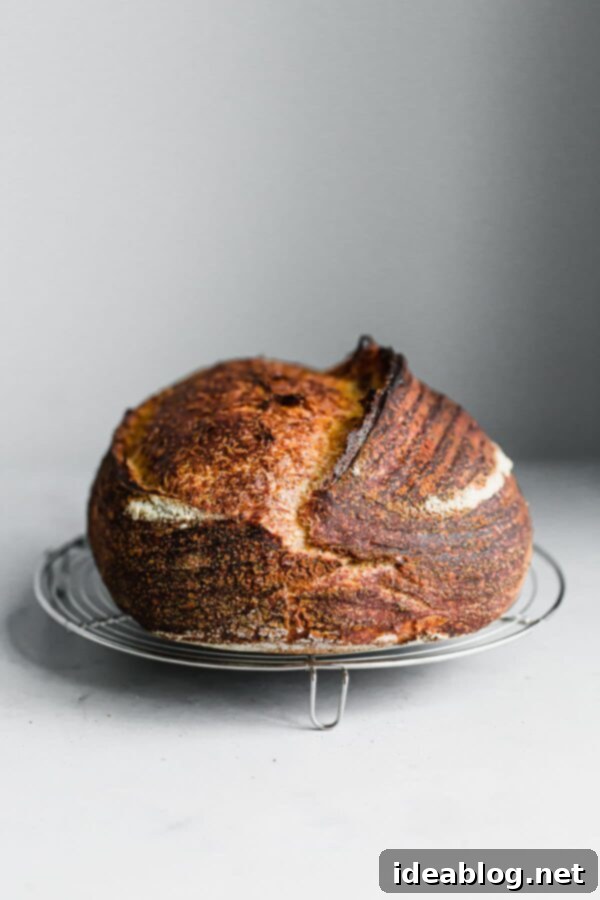
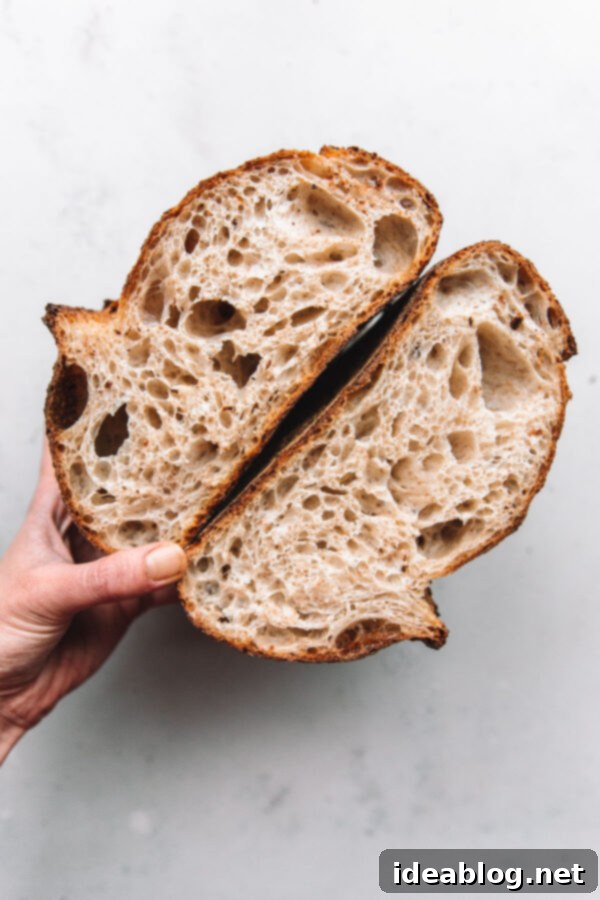
Recommended Equipment and Tools for Sourdough Success:
For this particular recipe, you will need at least the following essential tools. For a more comprehensive list and in-depth explanations, please refer to my complete guide to sourdough tools and resources:
- Challenger Bread Pan (a highly recommended investment), a 5 Quart Dutch Oven, or a Combo Cooker for optimal baking.
- A mature and active Sourdough Starter.
- An Instant-Read Thermometer (I highly recommend the Thermapen brand for its superior quality and accuracy).
- A Digital Baking Scale for precise measurements.
- A Bench Knife for handling and shaping dough.
- White Rice Flour, specifically for dusting your banneton basket to prevent sticking.
- An 8-inch Round or 11-inch Oval Banneton Basket (a basket that comes with a liner is particularly helpful for beginners).
- A Bread Lame (or a very sharp razor blade or sharp scissors) for scoring your loaf.
- A Serrated Bread Knife for clean slicing once cooled.
- Advanced Equipment Recommendation: A Brod & Taylor Proofing Box for precise temperature control during fermentation.
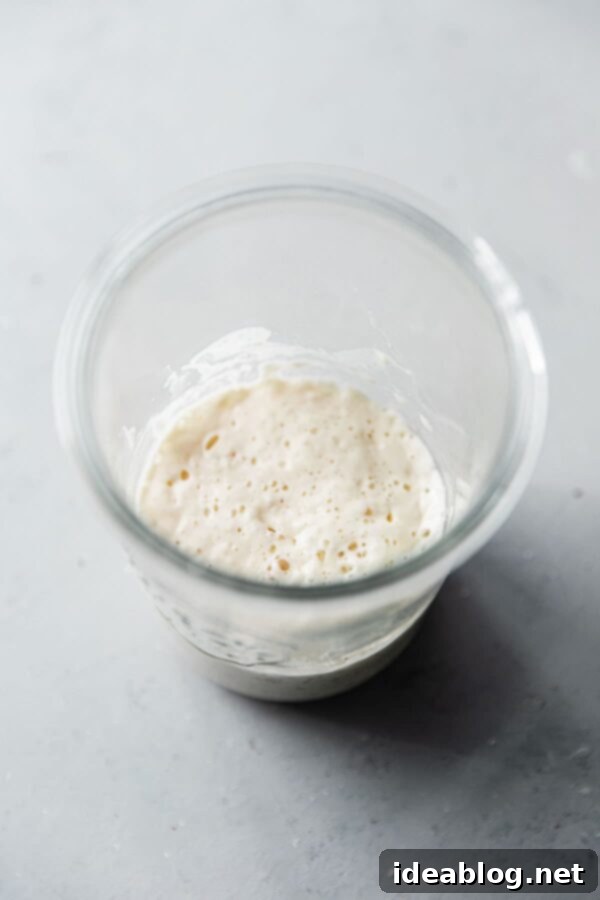
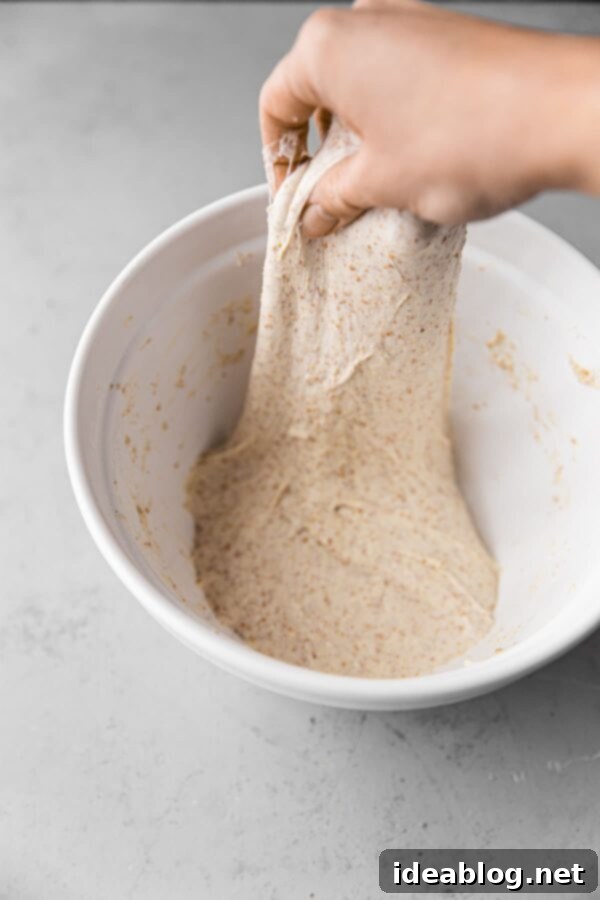
Example Bread Baking Timeline: Plan Your Sourdough Journey
Utilize this example timeline to efficiently plan your sourdough baking schedule, whether you’re tackling a loaf during the weekday or over a relaxed weekend. This detailed timeline is also conveniently available within the printable recipe box below. Remember, ambient temperature and your starter’s activity will influence these times, so use them as a guide and observe your dough.
DAY ONE: Fermentation & Shaping
- 8:30 AM – Autolyse: Mix flours and water. Allow the mixture to rest, covered, at 80°F/26°C for 1 to 2 hours.
- 9:30 AM – Add mature sourdough starter, mix thoroughly. Cover and rest at 80°F/26°C for 30 minutes.
- 10:00 AM – Add salt and mix thoroughly. Cover and rest at 80°F/26°C for 15 minutes.
- 10:15 AM – 10:45 AM – Perform Stretch and Folds #1, #2, #3 at 15-minute intervals. Cover and rest at 80°F/26°C between each set.
- 11:15 AM – 12:15 PM – Perform Stretch and Folds #4, #5, #6 at 30-minute intervals. Cover and rest at 80°F/26°C between each set.
- 12:15 PM – 2:15/3:15 PM – Bulk Fermentation (Rest): Allow dough to rest, covered, at 80°F/26°C. This period typically ranges from 1.5 to 2 hours, but can be significantly longer depending on ambient temperature, starter strength, and flour type. End bulk fermentation when the dough has nearly doubled in size and shows good aeration.
- 2:15/3:15 PM – Pre-shape: Gently shape the dough into a round. Leave uncovered at room temperature for 20 minutes to relax.
- 2:35/3:35 PM – Final Shape: Shape into your desired form (round or oval) and transfer to a rice-floured banneton basket. Cover with a plastic bag and seal. Allow to rest at room temperature for 10 minutes before transferring to the fridge.
- 3:45 PM – 7:45 AM (following day) – Final Proof (Cold Retardation): Place the covered dough in the refrigerator at 38°F/3°C for approximately 16-17 hours.
DAY TWO: Baking
- 6:45 AM – Preheat your Challenger Pan, Dutch Oven, or combo cooker in a 500°F/260°C oven for at least 1 hour.
- 7:45 AM – Remove dough from the fridge, transfer to the preheated pan, score the loaf, and bake at 500°F/260°C with the lid on for 25 minutes.
- 8:10 AM – Remove the pan lid, reduce the oven temperature to 475°F/240°C, and bake uncovered for about 20 minutes or until the crust is deeply caramelized. Allow the loaf to cool completely – this crucial step will take several hours – before slicing and serving to ensure optimal texture.
How to Store Sourdough Bread for Lasting Freshness:
You’ll likely find that a fresh loaf of homemade sourdough disappears remarkably quickly! However, if you happen to have any delicious leftovers, proper storage is key to maintaining its quality. Please consult my detailed guide on how to store bread.
This guide covers all the essentials for the best way to store, refresh a slightly stale loaf, and even freeze artisanal sourdough bread to enjoy at a later date, ensuring every slice is as good as the first.
Tips, Troubleshooting & FAQs:
Sourdough baking is a journey of learning, and encountering issues is a natural part of the process. If you’re experiencing any troubleshooting issues specific to this recipe or general sourdough baking challenges, please don’t hesitate to check out my comprehensive Sourdough Bread Troubleshooting Guide. It’s packed with solutions and answers to common questions, helping you achieve consistent success with your loaves.
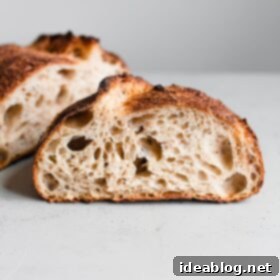
Artisan Sourdough Bread Recipe
4.9 stars (251 ratings)
Pin
Review
Save
1 (890 grams) Loaf
Please watch the instructional step-by-step process video (and how to bake sourdough in a Dutch oven) above before getting started. This is my favorite go-to everyday artisan sourdough bread recipe. Naturally leavened, this bread is prepared with a combination of high-protein bread flour (80%) and whole wheat flour (20%). This high hydration dough yields an airy, chewy, and open crumb with great flavor, and yields 1 round or batard loaf (890 grams), but can be easily doubled. Once mastered, switch up the flour ratios or add inclusions. This olive sourdough is a personal favorite!
Note: This is a high-hydration sourdough bread recipe and requires an active, mature sourdough starter. If you are new to sourdough bread baking, I recommend reducing the hydration (i.e., water) slightly (e.g., 310-330 grams water = 70%-75%). This will make the dough easier to handle and make it a bit easier to build strength in the dough. If you reduce the hydration significantly, reduce the number of stretch and folds to 4 total (30 minutes apart).
While sourdough requires little active time, it does require long inactive time and adequate planning. You can find an example baking timeline in the section above this recipe box.
Equipment
- Challenger Bread Pan
- Baking Scale
- Wire Monkey Bread Lame
Ingredients
- 350 grams unbleached bread flour (preferably organic, plus more for dusting)
- 90 grams whole wheat flour (preferably organic)
- 350 grams 90°F/32°C filtered water
- 90 grams ripe sourdough starter (100% hydration)
- 9 grams Diamond Crystal kosher salt or fine sea salt
- white rice flour (for dusting your banneton basket)
Instructions
-
New to sourdough baking? I highly recommend reducing the hydration in this recipe if you are new to sourdough baking. This is a high hydration dough and can be challenging to work with (and build strength in) if you’re not an experienced baker. If you’re looking for an easier to handle dough, I recommend reducing the water to 310 to 330 grams total. If you’re working with a lower hydration, you may be able to get away with just 3 to 4 sets of stretch and folds, or even less. Follow the dough’s lead!
-
IMPORTANT NOTE: I do not prepare an off-shoot levain for my sourdough baking, as this baking timeline and method works well for my schedule, as well as my starter’s feeding schedule. This choice is up to you and can be adapted/tweaked to fit your schedule, but please plan accordingly. Keep in mind that you’ll need to account for the starter quantity in the recipe (90 grams), as well as the normal quantity needed to continue to maintain and feed your starter.
-
Autolyse: In a large mixing bowl, whisk together 350 grams unbleached bread flour and 90 grams whole wheat flour. Add 350 grams (90°F/32°C) filtered water and mix with your hands until thoroughly combined and no dry bits are visible. Cover with a clean shower cap or plastic wrap, and rest at 80°F/26°C for 1 hour or up to 2 hours. This step hydrates the flours and helps build dough structure.
-
Add Starter and Rest: While this test isn’t foolproof, your sourdough starter should pass the ‘float test’ when it’s ready. Place a tiny spoonful of your ripe starter in a jar of water; it should float to the top. If it sinks, give it more time (15 to 20 minutes) and test again. Add 90 grams ripe sourdough starter and spread it over the autolyse mixture. Use your fingertips to spread the starter over the autolyse mixture. Fold the edges of the dough into the center to fully incorporate the starter. Use your thumb and fingers to pinch the dough (pincer method) repeatedly until the starter is well incorporated. Don’t be delicate. You want to work quickly, but fully incorporate the mixture. Cover and rest at 80°F/26°C for 30 minutes.
-
Add Salt and Rest: Sprinkle 9 grams salt over the surface of the dough. Use your thumb and fingers to pinch and incorporate the salt thoroughly (you shouldn’t feel any granules at the end of mixing) into the dough. Depending on the coarseness of your salt, this might take a couple minutes. Be thorough. Cover and rest at 80°F/26°C for 15 minutes. Important Note and Tip: If you’re struggling with higher hydration doughs and dough strength, there are two additional mixing methods that you can try: slap and fold or the Rubaud method. Please see the full video included in this post for visual demonstration.
-
Bulk Fermentation (Stretch and Folds): We will perform a total of 6 sets of stretch and folds (see article above for further instruction) in the first two hours of bulk fermentation. The first three will take place in 15-minute intervals. The remaining three will occur in 30-minute intervals. Covering and rest the dough at 80°F/26°C between each set. The dough will not rise much during the stretch and fold period, but it should get considerably stronger. Dip your hands in water (to prevent sticking) before each fold. I like to rub my hands together to avoid incorporating much more water, as this is already a high hydration dough.
How to Perform a Stretch and Fold: Grab the top portion of the dough with both hands. Gently pull and stretch it upwards (without tearing) and fold over the opposite edge. Rotate the bowl 180 degrees and repeat from the other side. Rotate the bowl 90 degrees and repeat once again on both sides. This entire process is one stretch and fold set. After performing the stretch and folds, I like to gently lift the dough to round it nicely in the bowl (see video). *If your dough is developing quickly, you can reduce the total number of stretch and folds to 3 or 4 sets, 30 minutes apart.
-
Bulk Fermentation (Continued Rest): Allow the dough to rest, covered at 80°F/26°C, for an additional 1.5 – 2 hours after the last stretch and fold – watch it carefully. Generally, I like to end bulk fermentation when the dough is just under double in size. This has produced good results for me and this guideline works well for this specific sourdough process and timeline. The total bulk fermentation time will vary tremendously based on your ambient kitchen temperature, dough temperature (FDT), flour type, and several other factors, so watch it carefully. Judging the right point to end bulk fermentation and move to the pre-shape period requires practice and trial-and-error.
At the end of bulk fermentation, the dough should be well aerated and there will be many gas bubbles on surface, as well as on the edges of the bowl (see video). The dough should be slightly rounded on the edges of the bowl. If the dough is flat, you most likely didn’t build enough strength during mixing, stretch and folds, or bulk.
-
Pre-Shape: Transfer the dough, without degassing, onto a clean countertop. It will be sticky. Use a bench knife to gently shape the dough into a round, pulling it gently towards you on the countertop in a circle to create some tension on the skin of the dough. As you do this, you’ll notice that the dough comes into a shape and starts to feel bouncy (see video). The key is to do this as quickly and gently as possible. Rest the dough, uncovered, for 15 to 20 minutes, or until it has relaxed slightly for the final shaping. Pre-shaping gives the dough some extra tension and strength (and is particularly important if you are doubling the recipe and preparing two loaves, as you’ll need to divide it prior). Allowing it to rest allows the gluten to relax slightly before performing the final shape.
-
Final Shape: Dust a 9-inch round or 10 or 11-inch oval banneton basket with rice flour (be extra liberal if you are not using a cloth or linen liner). Dust the surface of the dough lightly with bread flour. Use a bench knife to gently lift and flip it flour side down onto your countertop. Depending on your preference, banneton, or baking vessel, shape the dough into a round or batard. *Tip: Please watch the video above for visuals on how to shape a batard (oval loaf) or my latest video on how to shape rounds (boules) and bake in a Dutch oven. After shaping, gently pick up the shaped dough, flip, and transfer into your floured banneton, with the seam side facing up. Drape a kitchen linen over the banneton and place the banneton in a plastic bag (*I use a clean plastic produce bag). Seal with a clip and allow the dough to rest at room temperature for 10 minutes.
-
Final Proof: Place covered banneton basket in the refrigerator and retard dough for 15-16 hours at 38°F/3°C. This slow and cold fermentation stage helps develop flavor and improves the final crust texture.
-
Preheat the Oven: Preheat your Challenger Pan, Dutch Oven, or combo cooker (with lid on) in a 500°F/260°C oven for at least 1 hour.
-
Poke Test for Proofing: Once the oven and baking vessel have preheated for an hour, remove the banneton from the fridge and uncover. Test the dough for proper proofing by lightly flouring one small section (while the dough is still in the banneton). Press your finger lightly into the dough. A properly proofed dough should very SLOWLY spring back and still leave a light indentation. That is a sign of a well proofed dough that is ready to be baked. If it springs back quickly and completely, it is under-proofed (return to the fridge, covered, for an additional hour or so). If the dough compresses and doesn’t spring back at all, it is over-proofed. Unfortunately at that point, it’s hard to make up for in that stage of the process – but it will still taste delicious!
-
Transfer and Bake: If you are using a Challenger Pan or combo cooker, you can skip parchment and carefully invert the basket directly into the preheated base before scoring. If you are using a traditional Dutch oven, please watch this video for visuals: Place a large piece of parchment over the banneton, then top with a thin cutting board. Invert and flip carefully, so that the banneton is upside down, setting it down onto your countertop. The dough should release, right side up, from the banneton onto the parchment. Trim any excess parchment paper, creating two handles on both ends for lifting the dough. Use a bread lame to score the dough (1/2-inch deep), carefully transfer into the preheated pan, cover tightly with the lid, and place in the oven. Bake covered at 500°F/260°C for 25 minutes.
-
Remove the lid. The dough should have risen and expanded considerably, and the crust should be set, but only lightly golden in color.
-
Reduce the oven temperature to 475°F/240°C (*note: if your oven runs hot or your loaves are browning too quickly, reduce the temperature to 450°F/232°C) and continue to bake uncovered for an additional 15-25 minutes or longer until the crust is deep golden and caramelized. I like to rotate the pan several times during this final stage to ensure even browning.
-
Carefully remove the bread from the pan and transfer to a cooling rack. Cool completely before slicing. This will take several hours. Slicing into warm bread will result in a gummier texture and cause the bread to stale faster. For more tips, read this guide on how to store, freeze, and refresh sourdough.
How to Adapt This Recipe:
- Feel free to adjust the flour type percentages and hydration to suit your preferences, using the same total flour weight as a guide. Higher quantities of whole grain flours will yield a denser, less open crumb and will affect total bulk fermentation time.
Example Baking Timeline:
- DAY ONE:
8:30 AM – autolyse (mix flours and water). allow mixture to rest, covered, at 80°F/26°C for at least 1 hour or up to 2 hours.
9:30 AM – add sourdough starter, mix thoroughly. cover and rest at 80°F/26°C for 30 minutes.
10:00 AM – add salt and mix thoroughly. cover and rest at 80°F/26°C for 15 minutes.
10:15 AM – 10:45 AM – stretch and folds #1, #2, #3 (every 15 minutes). cover and rest at 80°F/26°C between each set.
11:15 AM – 12:15 PM – stretch and folds #4, #5, #6 (every 30 minutes). cover and rest at 80°F/26°C between each set.
12:15 PM – 2:15/3:15 PM – allow to rest, covered, at 80°F/26°C for the rest of the bulk fermentation period. this period will range anywhere from 1.5 to 2 (or significantly longer), depending on ambient temperature, starter strength, and flour variety. follow the dough’s lead!
2:15/3:15 PM – pre-shape. leave uncovered at room temperature for 20 minutes.
2:35/3:35 PM – final shape. transfer to rice floured banneton basket, cover with a plastic bag, and seal. allow to rest at room temperature for 10 minutes before transferring to the fridge.
3:45 PM – 7:45 AM – retard dough (final proof) in refrigerator at 38°F/3°C for about 16 hours.
- DAY TWO:
6:45 AM – preheat challenger pan, Dutch Oven, or combo cooker in 500F oven for at least 1 hour.
7:45 AM – remove banneton from fridge, transfer dough to preheated pan, score, and bake at 500°F/260°C, covered, for 25 minutes.
8:10 AM – remove pan lid, reduce oven temperature to 475°F/240°C, and bake uncovered for an additional 20 minutes or until deeply caramelized. allow loaf to cool completely (this will take several hours) before slicing.
Method inspired by The Perfect Loaf.
Serving: 1serving
Calories: 199kcal
Carbohydrates: 41g
Protein: 6g
Fat: 1g
Sodium: 366mg
Fiber: 2g
